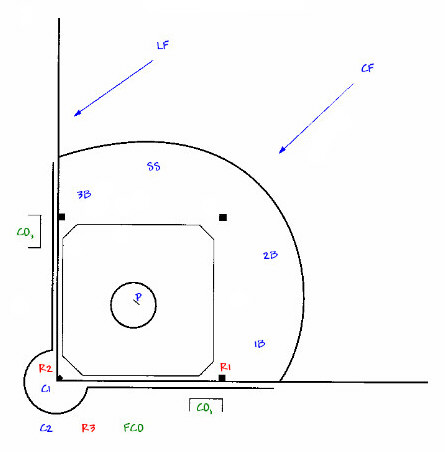| |

Although "Swipe and Wipe" can be considered a team defense drill, the primary purpose of the drill is for catchers to practice their throwing technique to prevent base stealing. It is a game situation drill. Runners attempt to swipe bases, and the defense tries to wipe the runners from the bases. One stage of bunt defense can be added to the swipe circuit to provide more variation to the offensive and defensive skills that are practiced.
Equipment: 4 Bases, Pitching Plate, Two Sets of Catcher's Gear, 3 Helmets, Bat, Baseballs Setup: Warm up a pitcher in the bullpen area before starting the drill. The pitcher can finish his throwing by participating in this drill. If more than one pitcher will throw, be sure to allow time for all pitchers to loosen their arms. Suit up two catchers. Place fielders at all infield positions. If 12 players or less participate, place fielders in CF and LF only. The offensive squad consists of three base runners. R1 begins the drill as a runner at first base. R2 assumes a hitting stance at the plate. R3 is in the on-deck area. Each runner moves around the bases in three stages. The stages in each round are:
1. Steal second base
2. Bunt runner from second base to third base
3. Double steal
Execution: R1 gets steal sign from third base coach. Catcher adjusts receiving stance to a throwing stance. Pitcher throws strike to batter. R1 breaks for second. 1B shouts to infield that the runner is going. R2 may take or swing through the pitch. Catcher moves upper body to stay behind the pitch as he receives it, and then quickly shifts into throwing position. Using proper foot work, he fires a rope to second. 2B and SS alternate covering the base to take the throw at second, and backing up the play. 3B moves to cover his base in the event an over throw occurs. LF moves to back up position behind third base for a possible throw. CF moves in to
back up the midfielders at second base. If the throw is errant or misplayed, runner continues to advance as far as possible. All fielders must react to the situation and attempt to halt the runner's advance at the next base. When play is ceased, R1 assumes a ready running position at 2B. Third base coach flashes the bunt signal to R2 at the plate. All runners glance down for a moment to allow the field coach to signal a bunt defensive play. After the defensive play is signaled, play begins. Pitcher throws a strike, R2 bunts the ball and races for first. On contact R2 breaks for third, and then reacts to bunt, e.g., returns to base if the ball is bunted in the air and caught. All the fielders move to their assigned positions to execute the bunt play that was signaled. Fielders concentrate to successfully convert the play by getting an out at either third base or first. The third stage begins with runners at the corners, (R1 at third and R2 at first). The third base coach signals for the runners to double steal. R3 assumes a hitting stance at the plate. All runners glance down for a moment to allow the field coach to signal a double steal defensive play. After the defensive play is signaled, the pitcher looks into the catcher for a sign. The pitcher throws a strike, and R2 breaks for second. The 1B shouts to infield that the runner is going. R3 may take the pitch or swing through it. The catcher moves his upper body to stay behind the pitch as he receives it, and then quickly shifts into throwing position. Using proper foot work, he initiates the defensive play by throwing to the assigned fielder or base. The base runners either continue their advance or react to the catcher's throw. The defense aggressively executes the play to wipe one of the runners from the bases, gaining an out and preventing a run from scoring. After two rounds, rotate catchers. Select a new offensive squad, and rotate the first squad of runners to defensive positions. Rotate each remaining fielder to an alternate defensive position. Fielding and Base Running Skills: Swipe and Wipe is more than catchers airing the ball out to bases. It emphasizes the importance of team defense and the unique role that each player has. If only one player is out of position or blows an assignment, the miscue can cost several bases. It all starts with pitching. In steal situations, the pitcher must throw strikes in order to give the catcher a good pitch to handle. In bunt situations, throw the high strike and look for the pop up double play. The 1B and SS must alert the infield of the runner's movements. The bases must all be guarded, and the outfielders must hustle to their backup positions. The basemen must convert the plays into outs by handling the throws properly and making aggressive low tags on the runners. This drill is an excellent opportunity to train catchers as the coach observes the catcher's body movements, most notably the feet. There are a few different methods of lower body movement that catchers can use, some are more advanced than others. The most common methods include the Jump Shift, Rock-and-Throw, and the Jab Step. Depending on the age, strength, and experience of the catcher, coaches should concentrate on helping catchers to learn and execute one method very well. The most common technique, and perhaps the easiest for young catchers to learn, is the Jump Shift. Regardless of which foot work is used, set as a goal that the catcher use one step or less before releasing the ball. One very common mistake that young catchers make is to carry the ball (multiple steps) before making the throw. A sequence of the catcher's movements to observe includes:
1. Set up in a throwing stance to receive the pitch.
2. Keep the butt beneath the ball as the pitch is received. In other words, keep a low center of balance.
3. Allow the pitch to come to the mitt, don't lunge for the ball.
4. Catch the ball with both hands working together.
5. Hands still together, with the glove push the throwing arm back to the cocked release point.
6. Close the front shoulder and hip to the base target.
7. Make an overhand throw with a four-seam grip.
Base runners practice their sliding technique and running with a mission attitude. They are also practicing communication with the base coaches. Coaches: At least three coaches is best, two base coaches to guide the runners and one field coach to set the defenses. A fourth coach can also work with defense by patrolling the outfield and keeping the outfielders alert and involved. Another option would be for the 4th coach to warm another pitcher in a bullpen area to substitute pitchers doing the rotations. If only two coaches are available, the 3B coach can run the offense and the 1B coach can run the defense. Variation: A variation of the drill is to eliminate the bunt stage and concentrate on base stealing only. Since the catcher's throw to third base does require different foot work than the throws to second base, coaches may want to include a steal of third base in the circuit. The set up is a bit different for this. R1 begins as the runner at first base. R2 stands out of the way at 2B. R3 is the batter. The progression is:
1. R3 stands in the batter's box with a bat as an inactive hitter.
2. R1 steals 2B, then returns to 1B at the conclusion of the play.
3. R2 becomes active a 2B, steals 3B.
4. R1 at 1B and R2 at 3B execute double steal.
5. Rotation: R2 to batter's box, R3 to start at 1B and R1 to start at 2B.
Rotate catchers and all players after three rounds.
Comments: As is often the case with game situation drills, Swipe and Wipe requires more logistical oversight than a simple skill drill. If the coach writes down a series of three or four player rotations beforehand, the drill can be set up quickly and will flow smoothly. The game rhythm pace helps the catchers improve their throwing skills, and it reinforces the necessity for all fielders to understand their role in team defense. The players enjoy the competition between the offensive and defensive squads. The length of the drill is dependent on the number of catchers involved. 15 minutes for one catcher is a good workout. For two catchers, push the drill to 20-25 minutes. For three or four catchers, about 30 minutes is necessary. After 30 minutes, it's better to move on to another drill. The player's focus will be pretty much exhausted by this time, and you will need to peak it again by practicing other skills.
|




